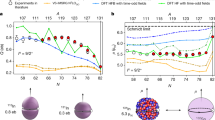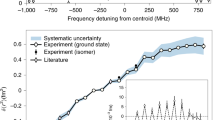Abstract
RELATIVISTIC effects have a considerable influence on the chemical behaviour of the heavier elements. Our Dirac–Fock one-centre expansion calculations1–3 indicate that the X–H bond lengths, Re, suffer a relativistic contraction of about 5% for PbH4 (ref. 1) or AuH (ref. 2) and 7% for TlH (ref. 3). If the relativistic effects are included, however, these Re values mostly agree with experiment to within 2–3%. Relativistic effects also seem to be the main cause of the chemical difference between silver and gold2 and, possibly, of the dominant monovalency of thallium3. A relativistic treatment becomes imperative to predict the chemical behaviour of the superheavy elements. Following evidence for primordial superheavy elements4, we present here results for the tetrahydride of the element 114 or eka-lead. We believe that such a calculation gives a reasonable estimate for the covalent radius of this element. Although the dominant valency of 114 is expected to be 2, some tetravalent compounds are also expected to be stable7. As the latter valency is more convenient for calculations, having closed shells, we here consider (114)H4.
This is a preview of subscription content, access via your institution
Access options
Subscribe to this journal
Receive 51 print issues and online access
$199.00 per year
only $3.90 per issue
Buy this article
- Purchase on Springer Link
- Instant access to full article PDF
Prices may be subject to local taxes which are calculated during checkout
Similar content being viewed by others
References
Desclaux, J. P. & Pyykkö, P. Chem. phys. Lett. 29, 534 (1974).
Desclaux, J. P. & Pyykkö, P. Chem. phys. Lett. 39, 300 (1976).
Pyykkö, P. & Desclaux, J. P. Chem. phys. Lett. 42, 545 (1976).
Gentry, R. V., Cahill, T. A., Fletcher, N. R., Kaufmann, H. C., Medsker, L. R., Nelson, J. W. & Flocchini, R. G. Phys. Rev. Lett. 37, 11 (1976).
Desclaux, J. P. At. Data Nucl. Data Tables. 12, 311 (1973).
Cotton, F. A. & Wilkinson, G., Advanced Inorganic Chemistry, 3rd ed. 309 (Interscience, New York, 1972).
Pitzer, K. S. J. chem. Phys. 63, 1032 (1975).
Tables of Interatomic Distances. (The Chemical Society, London, 1965).
Amberger, E. Angew. Chem. 72, 494 (1960).
Herzberg, G. Molecular Spectra and Molecular Structure. I. Spectra of Diatomic Molecules. (Van Nostrand, New York, 1950).
Author information
Authors and Affiliations
Rights and permissions
About this article
Cite this article
PYYKKÖ, P., DESCLAUX, J. Dirac–Fock one-centre calculations show (114)H4 to resemble PbH4. Nature 266, 336–337 (1977). https://doi.org/10.1038/266336a0
Received:
Accepted:
Issue Date:
DOI: https://doi.org/10.1038/266336a0
This article is cited by
-
Enhanced superconducting transition temperature via alloying In, Sn and Sb in PbH4 by using first-principles calculations
Journal of Materials Science (2023)
-
Pressure-induced superconductivity in H2-containing hydride PbH4(H2)2
Scientific Reports (2015)
-
Molecular structure of germylenes and their complexes
Journal of Structural Chemistry (1990)
-
Relativistic effects on molecular structure: methyl derivatives of the fourth main-group elements
Theoretica Chimica Acta (1986)
Comments
By submitting a comment you agree to abide by our Terms and Community Guidelines. If you find something abusive or that does not comply with our terms or guidelines please flag it as inappropriate.



